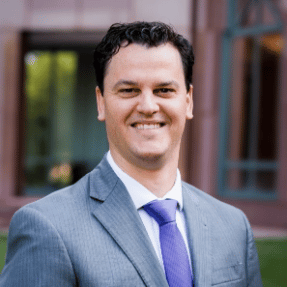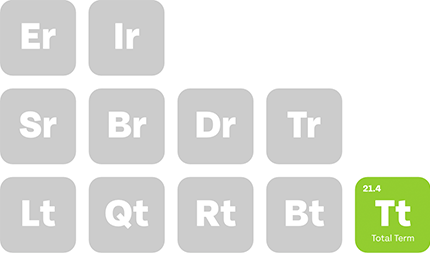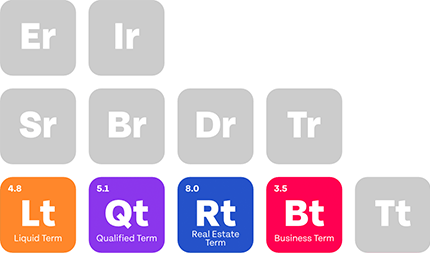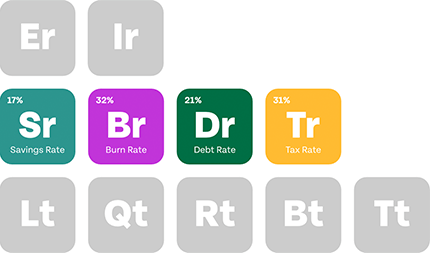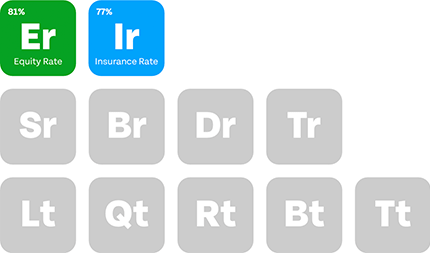Key Takeaways
- Average pay: the average cardiologist salary in 2025 is $520,000, ranking as the fourth highest-paid specialty.
- Subspecialty Gaps: Salaries vary widely by subspecialty, location, and experience. Invasive and interventional cardiologists consistently earn the most.
- Location Matters: Top states like Washington and the District of Columbia pay significantly more due to demand, shortages and competition.
- Gender Pay Gap: A widening gender gap exists — male physicians earn about 31% more than female physicians in 2025, the largest disparity in five years.
- Earning Potential: Protecting and optimizing your cardiologist salary through professional contract reviews and disability insurance is essential for long-term financial security.
Cardiology is a difficult and complex medical service. Yet, surprisingly, there are only 172,611 active cardiologists in the U.S. as of 2024.
The healthcare industry is struggling to respond to the increasing number of patients.
Additionally, it may take a considerable while before this struggle is resolved, as the numbers predict the problem will get worse by 2030.
This is why cardiologists are at the top of the view when it comes to their salary, being the fourth highest-paid specialty in all of medicine reflecting the strong cardiologist salary growth compared to most fields.
In this guide, we’ll give you an insight into those numbers and how you can boost your cardiologist salary even more.
Table of Contents
How Much Is the Average Cardiologist Salary?
The average cardiologist salary in the United States is around $520,000 a year, according to Medscape’s 2025 Cardiologist Compensation Report. While overall physician compensation rose 2.9% last year, cardiology saws a 1% decrease over the previous year’s $525,000 per year.
In both 2023 and 2024, Cardiology was the third highest-paid specialty in the United States, right after orthopedics and plastic surgery, but in 2025 it has fallen to the fourth-highest paid specialty, allowing radiology to rise to third place.
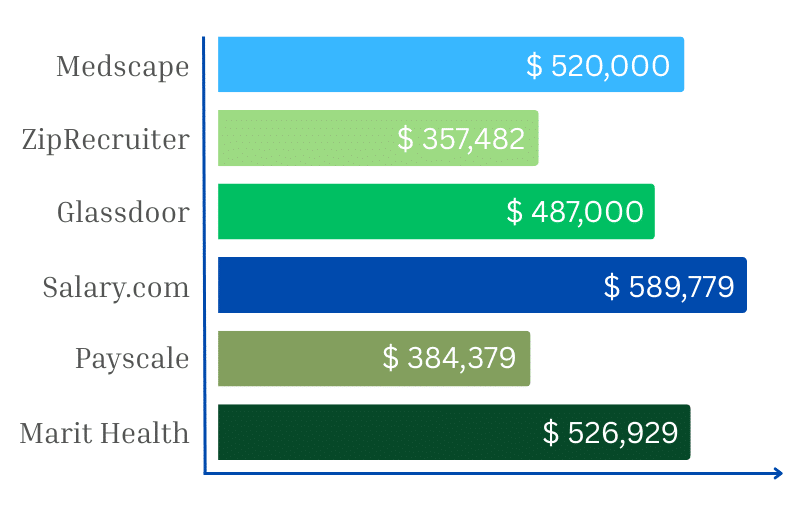
Not surprisingly, the percentage of cardiologist that feel fairly paid fell from 52% in 2024 to 48% in 2025.
Other sources around the internet are split, with some reporting higher and others reporting a lower cardiologist salary. This is because many factors can affect the salary. We’ll get to that in a little bit. For now, here are the sources:
- ZipRecruiter (2025): $357,482 (base salary only without bonuses or incentives)
- Glassdoor (2024): $487,000 (including additional pay)
- Salary.com (2024): $589,779 (including additional pay)
- Payscale (2024): $384,379 (base salary only)
- Marit Health (2025): $526,929 (base salary only)
Is There a Gender Payment Gap?
The 2025 Cardiologist Salary report didn’t specifically mention a gender payment gap between men and women. However, male specialists, in general, earn an average of $447,000 a year compared to females, who earn a considerably lower $339,000. That’s approximately 31%, the highest it has been in the last five years to date. Compared to last year’s 3% difference, the gap has widened significantly.
Related: How Female Physicians Can Counteract the Gender Pay Gap
Cardiologist Salary Varies Depending on the Specialty
Physician compensation always varies depending on years of experience.
Physicians further along in their careers almost always make more than newly licensed physicians. However, in cardiology, subspecialty is also a key factor in determining a physician’s cardiologist salary.
There are three main categories of cardiology practice:
- Noninvasive
- Invasive-Interventional
- Invasive (non-internventional)
The cardiologist salary for non-invasive specialists is on the lower end of the spectrum. In contrast, invasive and interventional cardiologists are some of the top earners in all of medicine. The chart below shows the low and high ends reported for each category:

- Non-invasive Cardiologists: $300,000 to $440,000
- Invasive Cardiologists: $361,000 to $455,000
- Interventional Cardiologists: $440,000 to $607,000
Within those three main categories, here’s how the average annual salaries of sub-specialists stack up:
- Electrophysiologists: $428,000 to $461,000
- Cardiac Transplant Surgeon:$683,000
- Nuclear Cardiologists: $414,000
- Echocardiologists: $481,000
- Pediatrics: $311,000 to $426,000
Discover: Where Do Electrophysiologists Make the Most Competitive Salaries?
Where Do Cardiologists Earn the Most?
Aside from your specialty, where you work also has a significant impact on your cardiologist salary, and it’s not just about the cost of living.
For example, here are the top-paying states where cardiologists earn the highest salaries:
| State | Annual Salary | Monthly Pay | Weekly Pay | Hourly Wage |
|---|---|---|---|---|
| Washington | $404,883 | $33,740 | $7,786 | $194.66 |
| District of Columbia | $403,964 | $33,663 | $7,768 | $194.21 |
| New York | $391,098 | $32,591 | $7,521 | $188.03 |
| Massachusetts | $390,414 | $32,534 | $7,507 | $187.70 |
| Alaska | $384,988 | $32,082 | $7,403 | $185.09 |
| Vermont | $380,094 | $31,674 | $7,309 | $182.74 |
| North Dakota | $378,245 | $31,520 | $7,273 | $181.85 |
| Oregon | $377,961 | $31,496 | $7,268 | $181.71 |
| Colorado | $375,899 | $31,324 | $7,228 | $180.72 |
| Hawaii | $371,409 | $30,950 | $7,142 | $178.56 |
On the other hand, here are the states where the cardiologist salary is on the low side:
| State | Annual Salary | Monthly Pay | Weekly Pay | Hourly Wage |
| Tennessee | $324,457 | $27,038 | $6,239 | $155.99 |
| Alabama | $324,018 | $27,001 | $6,231 | $155.78 |
| Kansas | $318,820 | $26,568 | $6,131 | $153.28 |
| Michigan | $311,580 | $25,965 | $5,991 | $149.80 |
| Kentucky | $310,483 | $25,873 | $5,970 | $149.27 |
| Louisiana | $305,692 | $25,474 | $5,878 | $146.97 |
| Georgia | $301,852 | $25,154 | $5,804 | $145.12 |
| Arkansas | $295,604 | $24,633 | $5,684 | $142.12 |
| West Virginia | $276,752 | $23,062 | $5,322 | $133.05 |
| Florida | $267,144 | $22,262 | $5,137 | $128.43 |
Source: ZipRecruiter (2025)
The states on the East Coast and West Coast usually pay cardiologists the most. Even though the cost of living is already high in these areas, hospitals and clinics have to compete with big academic centers and tech-driven healthcare hubs, which drives up pay. Pay is also higher in remote states like Alaska, Hawaii, and North Dakota because it’s harder to find doctors in these places.
On the other hand, several states in the South and Southeast pay cardiologists the least. These areas have cheaper costs of living, but they also have more doctors and hospitals that may have to work with smaller budgets, which means they don’t have to pay top dollar for doctors. Florida is an example of how high physician density in popular retirement areas can lower a cardiologsit salary, even in a place where there is a lot of demand for heart treatment.
Why Do Some States Pay Cardiologists More?
Physicians, including those who earn a cardiologist salary, almost always earn more when the demand for their skills is high and the supply of experienced physicians is low.
Regardless of why cardiologist shortages exist, states that have the biggest shortages of physicians usually pay the highest salaries — and those aren’t necessarily the states that have the highest costs of living or even a large aging population.
While the cost of living can also contribute to an income in cardiology, supply and demand usually have the largest impact on how much a cardiac physician is paid.
Related: 10 Best States to Practice Medicine
How Can You Protect Your Cardiology Income?
While there are salary ranges between primary care and specialty care, all physicians in the healthcare industry can take preventative measures to protect their cardiologist salary and long-term earnings.
Protect Yourself With a Professional Contract Review
Except for a cardiologist who owns their own practice, every employed cardiac specialist will be presented with an employment contract at some point in their career.
And no matter how many employment contracts you’ve signed in the past, every employment contract needs to undergo a thorough and professional review.
An employment contract review is the best way to ensure that your compensation is fair, that the responsibilities and duties of your job are what you expect them to be, and that the terms of your exit or termination are clearly stated.
A contract review is also a way to make sure that nothing has been omitted from the contract.
Therefore, here are some of the terms your contract should cover:
- Insurance benefits
- PTO
- Restrictive covenants
- CME reimbursements
- Ownership or partnership agreements (when applicable)
Therefore, without an attorney to review your contract, you could be in jeopardy of having to work under restrictive covenants, pay for medical malpractice tail insurance long after your contract ends, or take on longer shifts.
To learn more about contract review, read our Definitive Guide to Physician Contract Review now.
Protect Your Future Cardiologist Salary With Disability Insurance
Disability insurance is the single best way to protect your future unearned cardiology income.
Should you suffer an illness or injury that prevents you from working in the field of cardiology, disability insurance allows you to earn a portion of your income for a few years, all the way up to the age of retirement.
Disability insurance is not just for older physicians or cardiologists already suffering from current medical conditions. A disability can occur at any point in life. Therefore, it’s vital for younger physicians who stand to earn millions of future dollars throughout their careers.
Without disability insurance, you could find yourself in a position where you’re earning zero income or working in a role that pays far less than a job as a cardiologist would.
For more information on disability insurance and how to choose the right provider, click here to contact Physicians Thrive now.
Frequently Asked Questions
Is There a Shortage of Cardiologists?
The United States is facing a significant shortage of cardiologists, which is projected (by some sources) to reach a deficit of 120,000 by 2030. This shortage is driven by factors such as retirements, burnout, and an insufficient number of new cardiologists entering the field.
What Is the Highest Paid Specialty in Cardiology?
The highest-paid cardiology subspecialty is interventional cardiologists, with an average salary of approximately $440k-$660k. Cardiac transplant surgeons also report very high salaries (~$683K). By contrast, noninvasive cardiologists are on the lower end of the cardiology spectrum.
Why do some states pay more than others?
Compensation follows supply and demand. Coastal and academic-heavy regions pay more due to competition, while remote states (Alaska, Hawaii, North Dakota) must offer higher salaries to recruit. Lower-paying states (Florida, Louisiana, West Virginia) often have larger physician pools and tighter hospital budgets.
























